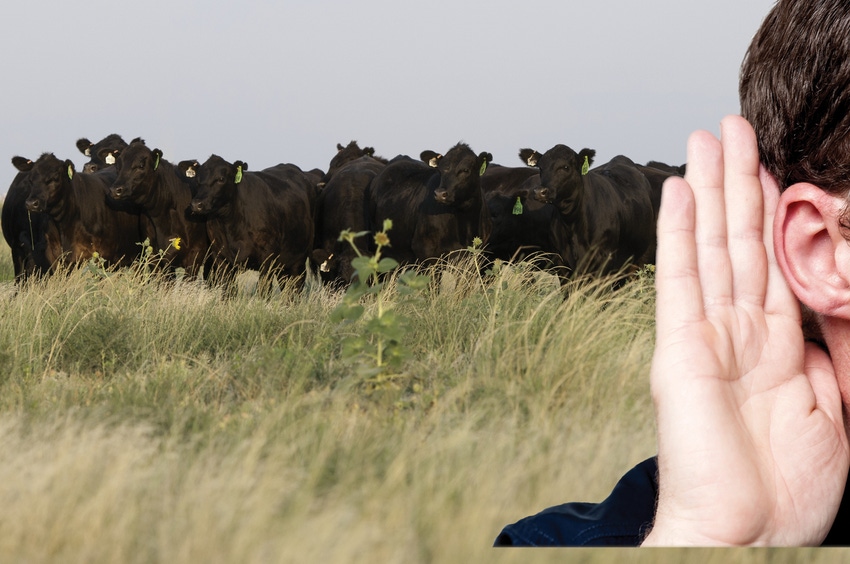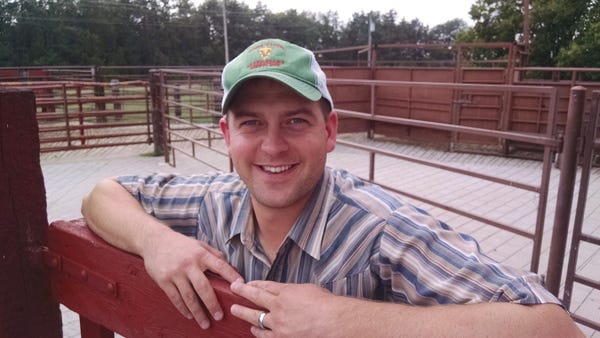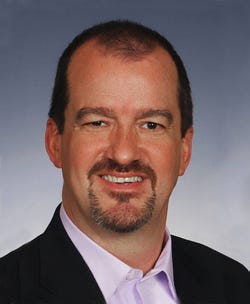There’s no single correct way to engage with consumers about topics important to them and the cattle business.Editor’s Note: This is the last in a series of BEEF Vet articles exploring the need for the cattle and beef industries to engage in public discourse with consumers in the name of preserving social license, and effective ways veterinarians and their clients can go about it. See part one and part two.
November 9, 2015

I got tired of people setting the tone for the conversation about what I do for a living,” says Jake Geis, DVM, of Tyndall Veterinary Clinic at Tyndall, S.D. “I sought a means to be part of the conversation in a meaningful way.”
Dr. Geis is explaining why, as a veterinary student at the University of Nebraska, he was possessed to go to the editor of the college newspaper and offer to write a column about some of the more contentious issues driving consumer conversations about agriculture in general, and about livestock agriculture, specifically.
“The editor liked it because it wasn’t just another college kid angry about something,” Dr. Geis recalls.

Jake Geis, DVM, Tyndall, S.D.
About the same time, the Masters of Beef Advocacy (MBA) program (funded by the beef checkoff) was taking flight. Dr. Geis took those courses and graduated.
“In the beef business, we tend to talk to other people who are in the beef business about these things rather than talking to other people,” Dr. Geis explains.
This same motivation drove Dr. Geis and his wife, Carolyn, also a veterinarian in the same practice, to establish their blog, “The Cow Docs” last year, about a year after becoming practicing veterinarians.
“The blog gives me the structure to have a wider audience and a more varied audience,” Dr. Geis explains. “I’m fairly new in the practice, but it also gives me more opportunity to communicate with others who are just starting their careers.”
This is part of effective advocacy—finding and focusing on the proverbial lemonade rather than the lemons. It’s about connecting with the audience at the nexus of what interests them. For instance one of Dr. Geis’ recent blogs was titled, “Vacationing when you’re broke.” He talked about a weekend getaway to Sioux Falls and gave some state history along the way. He never mentioned cows or agriculture.
Soon after, came this one: “Are there superbugs in my beef?” He addressed a popular Consumer Reports column that suggested ground beef at the grocery store was routinely contaminated with antibiotic resistant superbugs.
“The first contentious part of this report is their definition of a superbug. Their idea of a superbug is bacteria that is resistant to more than one type of antibiotic,” Dr. Geis wrote. “The problem with that definition is different species of bacteria are naturally resistant to different antibiotics. Think about it this way–the name bacteria correlates with an entire kingdom when you look at classifying organisms, exactly the same as the name plants does. Therefore, bacteria are as different from each other as pine trees are from bluegrass in your lawn.
“So when you spray your lawn with dandelion killer, the grass is naturally resistant to the spray. As a matter of fact, the grass is resistant to many different types of spray that kill dandelions. By Consumer Reports’ definition, that means bluegrass is a superplant.”
Along with tailoring the message to his particular audience, this also illustrates what Dr. Geis found to be true in his advocacy work: anyone you’re interested in engaging likely wears out if the only things ever addressed are negative or controversial.
“If you just talk about controversial subjects the whole time, you won’t have a consistent audience,” Dr. Geis explains.
About two-thirds of his blogs are about cattle, the other third are about rural living and topics that interest others he targets.
Dr. Geis describes the Tyndall Veterinary Clinic as two-thirds beef cattle and one-third everything else—dairy, equine, sheep and companion animals. Beef clients include mostly farmer-feeders with a lot capacity of 999 head or fewer and farmers who have cow herds of 75 to 300 head.
“If you try to reach everybody, you’ll wind up reaching nobody,” Dr. Geis says.
Of course, hitting nobody also results from doing nothing and targeting no one to start with.
There are no cookie-cutter formulas
“Everyone needs to find their own form of engagement. Not everyone is cut out to do Twitter or write a blog, and that’s fine,” says Daren Williams, executive director of communications at the National Cattlemen’s Beef Association. He directs the MBA program.
When the MBA program was taking shape, Williams explains one of the first inclinations was to beat activist groups at their own game. Briefly, such groups made plenty of hay out of “grassroots” letter writing campaigns that were nothing more than a mindless exercise of members typing their names in the blanks of a form letter and then hitting the send button.
“We want to foster the grassroots’ ability to respond based on their own experience and thinking for themselves,” Williams explains. “That’s why the MBA program doesn’t include a lot of specific talking points.”

Daren Williams, NCBA
Although there are no formulas, Williams explains guideposts along the MBA route include: listen, connect and share.
“The conversation with consumers should always begin by listening to what they’re telling us, so that we can fully understand where they’re coming from,” Williams says.
Here’s a simplistic illustration.
“You say you care about livestock, but let me tell you about the horrific video I saw…”
“I saw it, too. I’m as horrified as you are. Everyone in the business I know feels the same way. Here’s what we’re doing about it…”
The point, says Williams, is listening to understand not only the concern but also the motivation.
No one says any of this is easy.
For one thing, Dr. Geis points out there’s so much competition for everyone’s attention. “You almost have to think about it like an advertiser would. You have to figure out how to engage the audience,” he says.
Although the fear of controversy or confrontation keeps some on the sidelines of advocacy, Dr. Geis says he’s been surprised to encounter so little.
Yes, it’s frustrating to have someone in the crowd jump up to demand, for example, “Isn’t it true that you only use antibiotic to grow animals faster so you can make more money?”
Dr. Geis views it as an opportunity to speak to the people around that person.
Whether in his blog or in front of a group of people, Dr. Geis explains, “If you’re presenting information in an educational and friendly manner, you don’t have as much trouble with people who have a bone to pick.”
“The key is to be well-versed in order to speak to a number of areas at a top-line level,” Williams says. “Veterinarians are one of the most credible voices we have, particularly when we talk about the technological side of animal health (antibiotics, growth promotants, etc.)
“When I do advocacy work, I try to go into it with the same attitude I have when I go in to look at someone’s pet,” Dr. Geis says. “I know they will pepper me with questions, and I’ll give them facts and my suggestions to the best of my ability.”

Breathtaking photos of winter on the ranch
The first snow hit parts of the Midwest this week. Mentally prepare for the winter wonderland with these stunning photos. See photos here.
That also means he figures his clients, or consumers in the case of his blog, have first consulted with what he terms Dr. Google.
Unlike Dr. Google, though, Dr. Geis says, “They trust us because we’re veterinarians.”
A word about social media
“When we started the Masters of Beef Advocacy program in 2009, that was in the early days of social media. At that time our focus was on the need to get out and tell beef’s story,” Williams explains. “Ultimately, we can be out there pushing a lot of information. The next challenge is creating relationships.”
Briefly, Williams explains Facebook is more about connecting with people you already know. Twitter is about reaching beyond the people you know to develop new relationships.
“That’s why there is value in numbers,” Williams says. “The challenge is how we can always be there in the conversation.”
The other side of this is the conversation needs to be available to consumers whenever they want it, when walking into the store wondering about how they might use ground beef differently, for instance; when they’re waiting for their child’s doctor and have questions about antibiotic resistance, that kind of thing.
With more beef advocates participating in social media, there are others in the Twitter-verse and the kingdom of Facebook to carry on the conversation when you can’t be there.
The audience for “The Cow Docs” continues to grow steadily. A handful of Dr. Geis’ clients also follow the blog.
“They’re tickled because it’s fun for them to see what we’re doing with our own family’s cows. It helps build rapport with them,” Dr. Geis explains.
With clients, Dr. Geis says his advocacy represents a two-way street. It’s one with slightly different scenery than when chatting with consumers.
“I’m advocating to the consumer and also educating clients about how we can continue to do the best job we can,” Dr. Geis says.
As for non-clients, he adds, “If they have a relationship with the blog, they want to know more about you and your life.”
Dr. Geis also writes a column for a regional community paper aimed at livestock and pet owners.
Incidentally, Dr. Geis cautions that taking advantage of social media and public forums gives a new meaning to client confidentiality.
“I make a conscious effort to never identify clients or their cattle with anything I do,” Dr. Geis explains. That includes things like ensuring that cow pictures used in his blog or presentations don’t include a telltale brand, ear tag or landmark.
The conversation is shifting
Both Williams and Dr. Geis sense a shift in these kinds of societal conversations.
“I think the conversation is different than it was five years ago,” Dr. Geis says. “I think we’re shifting away from people saying animal agriculture is bad, so you should be a vegetarian, to industrial agriculture is bad, so you should buy local and grass-fed.
“At least that represents some people’s opinions changing from no beef to some beef,” Dr. Geis says. “If grass-fed beef can be their gateway drug, that’s fine with me. I would much rather they eat grass-fed beef than no beef at all. It gives my clients a better opportunity.”
Likewise, Williams says more folks in the mainstream science community and in the mainstream media have begun to challenge unscientific claims.
Noting the insanity of the anti-vaccination movement that left children dead from measles, Dr. Geis says, “Society is seeing the consequences of ignoring sound science.”
“The environment is changing constantly. It’s always shifting,” Williams says. “So, we have to shift with it. We have to keep the conversation going about beef and food. MBA graduates are doing a great job.”
Besides, Dr. Geis says the audience is a willing one.
“Consumers don’t know about these things. They just want to know more. They’ve been so far removed from agriculture that they’re fascinated by things we view as mundane,” Dr. Geis says.
One of his widest read blogs was about tubing a calf. He couldn’t think about anything to write about. His self-imposed deadline for posting his weekly blog was nigh, so he just wrote about the last thing he’d done that day.
In retrospect, it’s easier to deduce why the blog drew such readership. It’s something most know nothing about, would never think about. It demonstrates the lengths livestock producers go to in order to care for their stock. It’s completely transparent. Dr. Geis simply described what he did, how and why. There was no defensiveness on his part. It wasn’t a response to an attack from the other side. It was just giving folks who are interested a glimpse at something they know nothing about.
“You don’t have to do this on a large scale,” Dr. Geis says. “I’d start small. You see a lot of people who aren’t in animal agriculture, and you have the chance to engage with them when they bring in their dog or cat, or when you visit with them at coffee after church.”
He’s not talking about blogs, specifically. He’s talking about any means of advocacy, most of which often looks like good old fashioned conversation with folks who are already a part of your communication circle.
“Work with the people around you. Everyone in the world is only six degrees separated from everyone else,” Dr. Geis says. “You can make a big difference in a small circle.”

BEEF Seedstock 100
Looking for a new seedstock provider? Use our BEEF Seedstock 100 listing to find the largest bull sellers in the U.S. Browse the Seedstock 100 list here.
Dr. Geis shares the example of his mom, who likes to take pictures of their cattle with her phone camera. She started posting some of the pictures to her Facebook account. Friends outside of agriculture were captivated and took to naming them. So, Dr. Geis’ mom kept them apprised of the goings on with old Nellie, young Sophie, etc., including when one left because she came up open.
“They start connecting the dots and understanding more,” Dr. Geis says of the process. “If they just understand basic things, it’s easier to bridge the gap with more complex things. Half or more of the clients who come to our clinic have a Facebook page. A lot of them don’t know anything about cattle.”
“Farmers and ranchers are feeling more empowered to engage in these conversations,” Williams says. “More are doing it, and the MBA program has been a part of empowering and equipping them. We’re (all advocates) making a difference and that’s the difference we have to make.”
Masters of Beef Advocacy programs
“I would encourage people to go through the Masters of Beef Advocacy (MBA) program,” says Jake Geis, DVM, of Tyndall Veterinary Clinic at Tyndall, S.D.
Begun in 2009 and funded by the beef checkoff, the MBA program is a free, self-directed online training program designed to equip beef producers and industry allies with the information they need to be everyday advocates for the beef industry. To complete the course, MBA students are required to complete five courses in beef advocacy, including: The Beef Community, Raising Cattle on Grass, Life in the Feedyard, From Cattle to Beef, and Beef. It’s What’s For Dinner.
“If you have a cow-calf practice, I guarantee you have a dead time during the year,” Dr. Geis says. “You can find five hours to go through the MBA program.”
A new version of courses is also available called MBA 2.0.
“The new modules will address environmental sustainability, beef nutrition, animal welfare and beef safety while taking users through the beef life cycle, from pasture to plate,” explains Daren Williams, executive director of communications at the National Cattlemen’s Beef Association. He directs the MBA program. “The courses also offer historical context on the evolution of the U.S. beef industry from the time the first cattle were brought to North America to today.”
There are 7,000 MBA graduates to date.
For more information and for the online application, go to Master of Beef Advocacy.
You might also like:
WHO backpedals on red meat/cancer link
65 photos that celebrate cowgirls & cattlewomen
5 tips for getting the most cash for your cull cows
3 steps to negotiating a great cow lease
15 favorite photos of hardworking American ranchers
About the Author(s)
You May Also Like





